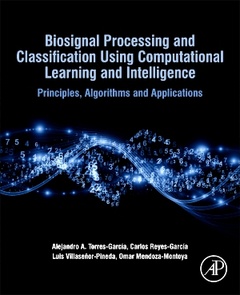Description
Biosignal Processing and Classification Using Computational Learning and Intelligence
Principles, Algorithms, and Applications
Coordinators: Torres-García Alejandro A., Reyes Garcia Carlos Alberto, Villasenor-Pineda Luis, Mendoza-Montoya Omar
Language: English
Subjects for Biosignal Processing and Classification Using...:
Keywords
signal processing; biosignal processing; electrocardiogram; ECG; balistocardiogram; phonocardiogram; electroencephalogram; EEG; Functional Near-Infrared Spectroscopy; Fourier transform; wavelet transform; Artificial Neural Networks; Machine Learning; Deep Learning; Artificial Intelligence; Computer-Aided Diagnosis; CAD; hybrid systems; computer-aided classification; classification; segmentation
536 p. · 19x23.3 cm · Paperback
Description
/li>Contents
/li>Biography
/li>Comment
/li>
PART 1 INTRODUCTION 1. Introduction to this book 2. Biosignals analysis (heart, phonatory system, and muscles) 3. Neuroimaging techniques
PART 2 BIOSIGNAL PROCESSING: FROM BIOSIGNALS TO FEATURES’ DATASETS 4. Pre-processing and feature extraction 5. Dimensionality reduction
PART 3 COMPUTATIONAL LEARNING (MACHINE LEARNING) 6. A brief introduction to supervised, unsupervised, and reinforcement learning 7. Assessing classifier’s performance
PART 4 COMPUTATIONAL INTELLIGENCE 8. Fuzzy logic and fuzzy systems 9. Neural networks and deep learning 10. Spiking neural networks and dendrite morphological neural networks: an introduction 11. Bio-inspired algorithms
PART 5 APPLICATIONS AND REVIEWS 12. A survey on EEG-based imagined speech classification 13. P300-based brain–computer interface for communication and control 14. EEG-based subject identification with multi-class classification 15. Emotion recognition: from speech and facial expressions 16. Trends and applications of ECG analysis and classification 17. Analysis and processing of infant cry for diagnosis purposes 18. Physics augmented classification of fNIRS signals 19. Evaluation of mechanical variables by registration and analysis of electromyographic activity 20. A review on machine learning techniques for acute leukemia classification 21. Attention deficit and hyperactivity disorder classification with EEG and machine learning 22. Representation for event-related fMRI
Carlos Alberto Reyes García Garcia is a full-time researcher in the Department of Computer Science, the head of the Bio signal Processing and Medical Computing laboratory, and is the founding Coordinator of the Graduate Program in Biomedical Sciences and Technologies as of August of 2017. at the Instituto Nacional de Astrofísica Óptica y Electrónica in Puebla, Mexico since January 2001. He holds a PhD degree in computer science with a specialty in artificial intelligence from Florida State University in Tallahassee, Florida. He is a Level II National Researcher of the National System of Researchers (SNI). He is the national president of the Thematic Network on Applied Computational Intelligence from 2016 to date, IEEE Senior Member and AMEXCOMP invited member He was President of the board of directors of the Mexican Society of
- Provides coverage of the fundamentals of signal processing, including sensing the heart, sending the brain, sensing human acoustic, and sensing other organs
- Includes coverage biosignal pre-processing techniques such as filtering, artifiact removal, and feature extraction techniques such as Fourier transform, wavelet transform, and MFCC
- Covers the latest techniques in machine learning and computational intelligence, including Supervised Learning, common classifiers, feature selection, dimensionality reduction, fuzzy logic, neural networks, Deep Learning, bio-inspired algorithms, and Hybrid Systems
- Written by engineers to help engineers, computer scientists, researchers, and clinicians understand the technology and applications of computational learning to biosignal processing




